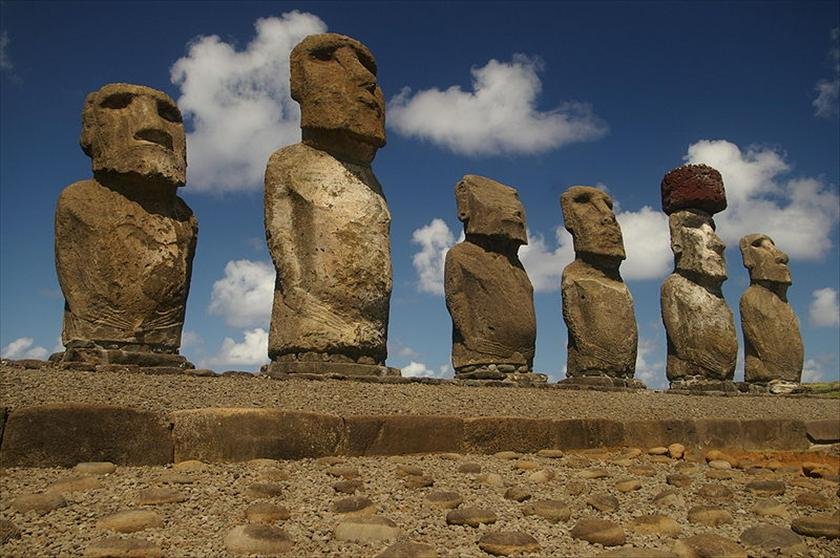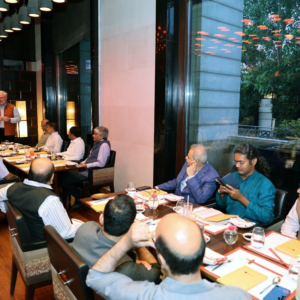A few years ago, this analyst tried to study the reasons why dynasties, regimes and civilisations collapsed.[i] In an essay, written when the country was gearing up for national elections after a ten-year stint of the Congress-UPA regime at the Centre, I focused on the widespread discontent with the Central Government and the Congress Party that was sweeping the nation.
As a matter of fact, many analysts and observers were predicting the end of the hegemony of the Congress Party that had more or less been continuously in power in New Delhi since 1947, when the country became independent. The number of years when we had non-Congress regimes in the Union Government could be counted on one finger tip.
However, the halcyon days of the grand old Indian party and the Nehru family were clearly coming to an end. It is against this backdrop that I attempted to study how similar changes had taken place in history. For the benefit of lay readers, this article took up a number of examples from the past, when empires, regimes, juntas and dynasties had collapsed in different parts of the world. I did add the cautionary note that the Congress Party (under the leadership of the Nehru-Gandhi family) had displayed remarkable survival skills over many decades.
It was because of this dexterity in coping with existential threats and risks, that many observers, researchers and scholars were still hesitant in the first quarter of 2014 to classify the indigenous Grand Old Party (GOP) as a death-bed case. Yet, the warning signs were inescapable—the Congress ship was taking in too much water and the captain and crew in the ship’s bridge were manifestly ineffective. The essay then went on to pose the basic question that Edward Gibbon had asked in his landmark study (The Decline and Fall of the Roman Empire) more than two-and-a-half centuries earlier. The great scholar wrote: “Instead of inquiring why the Roman Empire was destroyed, we should rather be surprised that it had subsisted for so long.”
I couldn’t resist adding tongue-in-cheek that the study of the collapse of the Roman Empire was most appropriate in the second decade of the twenty-first century because of the Italianate ambience of our country these days. Gibbon had also stressed that the Roman collapse could also be attributed to “immoderate greatness”. Moreover, “prosperity ripened the principle of decay; the cause of the destruction multiplied with the extent of conquest; and, as soon as time or accident had removed the artificial supports, the stupendous fabric yielded to the pressure of its own weight.”
In a light-hearted interjection, the description of the Congress Party as an organisation that possessed “immoderate greatness” was also queried. Thereafter, the essay went on to assess the French Revolution as another major example of a collapse of a dynasty and regime. I described the pre-revolutionary society of France in the second half of the 18th century as a classic template of a completely decadent, inefficient and corrupt system, that had a very close resemblance to the Indian one in 2014.
The economic inequalities in pre-Revolutionary France were appalling, and comparable to the Indian one in 2014. Some segments of the population, like the nobility and the clergy, were exempted from taxation, just like in India. At an informal level, private tax collectors extracted more money than the government’s requirement, the additional amount being pocketed by them, a scenario very similar in these shores. All these problems were aggravated by inflation and malnutrition of many ordinary citizens.
The final parallel was that the French Queen, Marie Antoinette, was a totally unpopular Austrian-born import. The statement “if they can’t get bread, let them eat cake” that was widely attributed to her, was not proved beyond reasonable doubt, but resentment against her lent it credibility. The Indian experience of the extra-loyal courtiers of the Nehru-Gandhi family could have come straight from the Versailles court in the 1780s.
The last example that the essay of 2014 studied was the Russian Revolution of 1917, something that should be most uncomfortable for the Indian communists of various hues who are still around in our country.
In Tsarist Russia, industrialisation had come many years after western Europe and the U.K. The country was predominantly agrarian, with the majority of farmers being small and marginal producers. Statistically, this demographic segment also constituted the predominant majority of the country’s population. The government had given these people small tracts of land that were barely cultivable and they were obliged to pay the state a prescribed sum of money for their “freedom”. The result was widespread indebtedness, poverty and subsistence-farming among the farmers. Large-scale immigration of farmers to urban areas was the natural outcome. Half the farming families had one member at least who had left the village to find other work in the towns. As the central Russian population boomed, land became scarce. The appalling life-standard of the peasants was in sharp contrast to that of the rich landowners, who held 20% of the land in large estates and were often members of the Russian upper class. The resemblance to India is something that cannot be overlooked.
In the industrial sector and in the urban areas, the situation was equally dismal and here again there are many similarities to the Indian scenario. Russia’s cities began to expand and large numbers of peasants moved to the cities to take up new jobs. By the turn of the nineteenth century, millions of Russians were in these tightly-packed and poorly-planned urban conglomerations, experiencing problems like poor and cramped housing, insufficient wages, and limited rights in their jobs.
The government was afraid of the developing urban class, but more afraid of driving foreign investment away by supporting better wages, and, therefore, the country never saw any serious legislation for reforming the awful economic system that prevailed. It should also be stressed that the urban work-force continued to retain close links and ties to their agricultural families. The similarities with India are manifestly clear.
Soon Tsarist Russia witnessed major social unrest, and revolutionary movements started emerging. The Romanov Tsar Nicholas II had no clue about the solution to the country’s crisis. The millstone around his neck was his wife, the German-born Tsarina Alexandra, and her advisors. In 2014 and thereafter, this syndrome of another foreign-born ruler was, naturally most awkward for the Congress power-centres in 24 Akbar Road and 10 Janpath. Suffice to say, a few months after the essay was published, the Congress and its allies were swept away in a gigantic political tsunami that had all the hallmarks of long pent-up forces being suddenly unleashed. The same happened after another five years, when in May-2019, the new rulers were re-anointed in power with a greater mandate.
Readers should be reminded that the landmark study which inspired this analyst’s article in 2014 was Joseph Tainter’s book published three decades ago in 1988.[ii] It is to this primary source that we will now return, as we continue our assessment of the subject. This magnum opus examines the collapse of the Mayan and Chacoan civilisations, and of the Western Roman Empire, in terms of network theory, energy economics and complexity theory. Tainter puts forward the thesis that sustainability or collapse of societies depend upon the success or failure of problem-solving institutions. Furthermore, regimes and societies crumble when their “investments in social complexity and their energy subsidies reach a point of diminishing marginal returns.” He foresees collapse when a society involuntarily jettisons an important proportion of its complexity.
In this theoretical framework of Tainter, societies become more complex as they try to solve problems. Social complexity is present when many different and specific social and economic roles, as well as the numerous mechanisms through which they are coordinated, can be identified. Another ingredient is the reliance on symbolic and abstract communication, as well as the existence of a class of information producers and analysts who are not involved in primary resource production. A complex structure like this needs a considerable amount of “energy” subsidy (meaning the consumption of resources, or other forms of wealth).
When a society confronts a “problem,” such as a shortage of energy, or difficulty in gaining access to it, it tends to create new layers of bureaucracy, infrastructure, or social class to address the challenge. Tainter identifies seventeen examples of rapid collapse of societies. However, his detailed case studies are those where he applies his model to the Western Roman Empire, the Maya civilisation, and the Chaco culture.
For example, as Roman agricultural output slowly declined and population increased, per-capita energy availability dropped. The Romans tried to resolve this problem by conquering their neighbours to appropriate their energy surpluses (in concrete forms, like metals, grain, slaves, etc.). However, as the Roman Empire grew, the cost of maintaining communications, garrisons, civil government, etc. increased disproportionately. Eventually, this cost became so high that any new challenges such as invasions and crop failures could not be solved by the acquisition of more territory.
Intense, authoritarian efforts to maintain cohesion by Domitian and Constantine the Great only led to a growing strain on the population. The Empire split into two halves, of which the western unit soon fragmented further into smaller units. The eastern half, being wealthier, was able to survive longer, and did not collapse but instead succumbed slowly and piecemeal, because unlike the western empire it had powerful neighbours able to take advantage of its weakness.
It is often assumed that the collapse of the western Roman Empire was a catastrophe for everyone involved. Tainter points out that it can be seen as a very rational preference of individuals at the time, many of whom were actually better off after the collapse. Tainter notes that in the west, local populations in many cases greeted the barbarians as liberators.
It must be pointed out that Tainter, in his 1988 study, drew upon a wealth of earlier studies by a number of titanic scholars on the broad issue of regime-collapse. These included Edward Shils[iii], Pitirim Sorokin[iv],[v], Paul Valery[vi], among others. The essence of all these studies is that complex societies are problem-solving organisations, in which more and different kinds of parts, more social differentiation, more inequality, and more kinds of centralisation and control emerge as circumstances require.
The increase in complexity of societies over the centuries has involved a change from small, internally-homogeneous, minimally-differentiated groups characterised by equal access to resources, shifting, ephemeral leadership, and unstable political formations, to large, heterogeneous, internally-differentiated, class-structured and controlled societies, in which the life-sustaining resources are not equally available to all. Modern society requires and demands constant legitimisation and reinforcement.
The process of collapse is a matter of rapid, substantial decline in an established level of complexity. A society that has collapsed is suddenly smaller, less differentiated and heterogeneous, and characterised by fewer specialised parts. Because it has less social differentiation, it is able to exercise less control over the behaviour of its members. At the same time, it is able to generate smaller surpluses, to offer fewer benefits and inducements to membership. It is less capable of providing subsistence and defensive security for a regional population. It may decompose to some of the constituent building blocks (e.g. states, ethnic groups, villages) out of which it was created.
The loss of complexity, like its emergence, is a continuous variable. Collapse may involve a drop between the major levels of complexity envisioned by many anthropologists (e.g. state to chiefdom), or it may equally well involve a drop within a level (larger to smaller, or transitional to typical or Inchoate states). Collapse offers an interesting perspective for social scientists. It is a process of major, rapid change from one structurally-stable level to another.
Tainter begins by categorising and examining the often inconsistent explanations that have been offered in various studies for collapse. In Tainter’s view, while invasions, crop failures, disease or environmental degradation may be the apparent causes of societal collapse, the ultimate cause is an economic one, inherent in the structure of society, rather than in external shocks, which may batter them. On the intricate issue of diminishing returns on investments in social complexity, he musters up enough modern statistics to show that marginal returns on investments in energy, education and technological innovation are diminishing today. The globalised modern world is subject to many of the same stresses that brought older societies to ruin.
However, Tainter is not entirely apocalyptic: “When some new input to an economic system is brought on line, whether a technical innovation or an energy subsidy, it will often have the potential at least temporarily to raise marginal productivity”. Thus, barring continual conquest of a country’s neighbours (which is always subject to diminishing returns), innovation that increases productivity is, in the long run, the only way out of the dilemma of declining marginal returns on added investments in complexity.
And, in the final chapters of his 1988 tome, Tainter discusses why modern societies may not be able to choose to collapse, because surrounding them are other complex societies, which will in some way absorb a collapsed region or prevent a general collapse. The Mayan and Chaocan regions had no powerful complex neighbours and so could collapse for centuries or millennia, as could the Western Roman Empire, but the Eastern Roman Empire, bordered as it was by the Parthian / Sassanid Empire, did not have the option of devolving into simpler smaller entities.
Now is the appropriate stage to raise some red flags about Tainter’s book. In its scope and coverage, it is indeed encyclopaedic, but that is also its drawback. Tainter draws such an enormous canvas that he often gets lost in it. His conclusions, in many instances, are often revised partially in subsequent segments. Consequently, he sometimes appears to be meandering and “provisional”. Other scholars like Valery and Shils come out very often as much more focused than Tainter.
This is a pity, because a path-breaking research study has recently been published by a group of Italian statisticians / mathematical economists that clearly validate Tainter’s major propositions. In their 2019 paper[vii], Ugo Bardi, Sara Falsini and Ilaria Perissi have made a very convincing case in favour of Tainter’s theories on collapse of societies or large/complex social systems, often referred to as civilisations or empires. The Italian scholars presented a mathematical model which proves the theory that societies collapse because of the “diminishing returns of complexity”, as propounded by Tainter in his 1988 book.
The Bardi-Falsini-Perissi model is much too complex and esoteric to be assessed here in detail. In lay terms, we can briefly summarise their work. According to their model, a socio-economic system is a chain of energy stocks which dissipate the energy potential of the available resources. The exploitation of a non-renewable resource stock (“production”) has a strongly non-linear relation with the complexity of the system. As the entire mechanism continues working, it produces various trajectories of decline of the economy. In some cases, the decline is so pronounced that it can be defined as “collapse.”
More research in this extremely interesting area is now also available from other scholars who have carried on where Tainter ended in 1988. Peter Turchin, another Russian-born social scientist who has a vast analytical canvas like his fellow-Russian, Sorokin, has followed Tainter’s theories by suggesting a single mechanism that leads to collapse. This mechanism is the loss of “social resilience” which Turchin describes as the ability of a social system to “cooperate and act collectively for common goals”.[viii]
According to Turchin, the United States was collapsing well before Covid-19 erupted in the country in early 2020. For the last 40 years, he argues, the population has been relentlessly getting impoverished and more unhealthy, while the elites accumulated more and more wealth. All the while, the legitimacy of institutions is continuously getting eroded, and institutional legitimacy founders. “The United States is basically eating itself from the inside out,” he says.
Inequality and “popular immiseration” have left the country extremely vulnerable to external shocks like the pandemic, and to internal triggers like the George Floyd affair. Turchin does not hesitate to predict that the U.S., in the years to come, can expect much more of the variety of social upheaval that it saw in 2020. This is simply because the “underlying conditions are only getting worse.” Clearly, the Tainter school of civilisational collapse has enrolled new proponents and advocates, who will continue to enlarge the boundaries of this most captivating sociological doctrine.
(Author Brief Bio: Jay Bhattacharjee is an advisor in corporate laws and finance, based in Delhi. His other areas of interest include socio-political issues and military history. He has been a commentator and columnist from the mid-1990s)
[i] Jay Bhattacharjee – Collapse of Dynasties–a Congress Case Study (INDIAFACTS, 6 February 2014) (http://indiafacts.org/collapse-of-dynasties-a-congress-case-study/)
[ii] Joseph A. Tainter – Collapse of Complex Societies, Cambridge University Press, 1988
[iii] Edward A Shils – Center and Periphery: Essays in Macrosociology, University of Chicago Press, Chicago, 1975
[iv] Pitirim A Sorokin – Social Philosophies of an Age of Crisis, Beacon Press, Boston, 1950
[v] Pitirim A Sorokin – Social and Cultural Dynamics, Porter Sargent, Boston, 1975
[vi] Paul Valery – History and Politics (translated by Denise Folliot and Jackson Mathews), Bollingen, New York, 1962
[vii] Ugo Bardi, Sara Falsini and Ilaria Perissi – Toward a General Theory of Societal Collapse: A Biophysical Examination of Tainter’s Model of the Diminishing Returns of Complexity, BioPhysical Economics and Resource Quality Volume 4, Article number: 3 (2019
[viii] Jack A. Goldstone and Peter Turchin – Welcome to the Turbulent Twenties (Berggruen Institute) (https://www.noemamag.com/welcome-to-the-turbulent-twenties/)





Dear Jay Babu,
Namaskar. Read your excellent article with a list of references fully. I must confess that I am blissfully ignorant of the scholars mentioned therein. However, it is an educational experience. May I ask what is its relevance with respect to the expanding BJP today after some years or decades? Will it go like the INC? – SC Panda